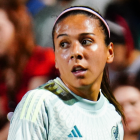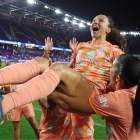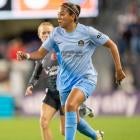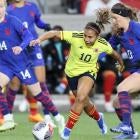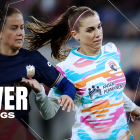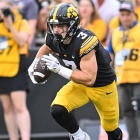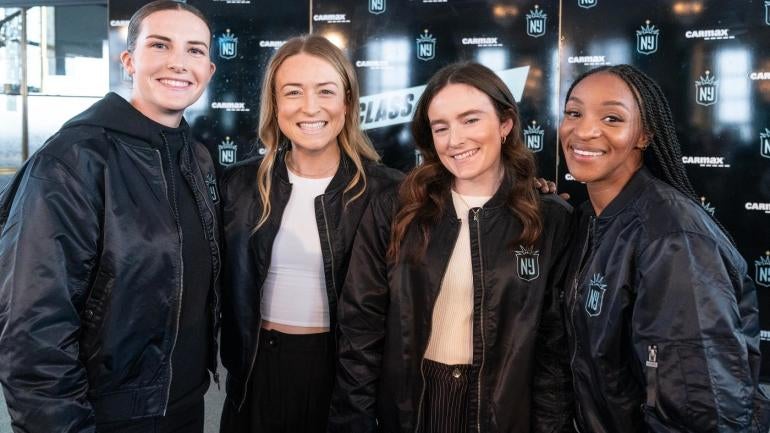
While the endlessly entertaining 2023 NWSL season was still playing out, the free agency list that dropped that September teased an equally dramatic offseason that lived up to the hype. A sizable number of high-profile players moved from one club to another during the league's second-ever free agency period, showcasing the impact that freedom of movement can have for players who were enjoying such privileges for the first time.
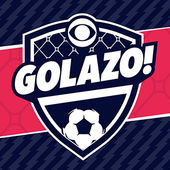
Golazo Starting XI Newsletter
Get your Soccer Fix from Around the Globe
Your ultimate guide to the Beautiful Game as our experts take you beyond the pitch and around the globe with news that matters.
Thanks for signing up!
Keep an eye on your inbox.
Sorry!
There was an error processing your subscription.
The perks for players are obvious ones. Free agency allows players to search for ideal financial terms, a desired professional environment and a proximity to loved ones, among other priorities. Simply put, it changes the power dynamics in a league that has long only afforded clubs the ability to pick and choose.
"It felt really nice to take control over a situation and meet with clubs and be able to say, 'What's so great about the club? What do you guys have to offer?'" Crystal Dunn, one of several splashy free agents who signed for NJ/NY Gotham FC this winter, told CBS Sports. "I really enjoyed the process and it made me feel valued as a player."
That is merely scratching the surface on free agency's seismic impact on the NWSL, though. The new player movement measure is one of several introduced in recent years that, directly or indirectly, is designed to increase standards around the league just as other competitors around the world become competitive.
"This is pushing clubs to be better, to be better than each other, it kind of puts them in a race," new Gotham player Tierna Davidson told CBS Sports. "I feel like it's pushing everyone to be better and there's more intensity and there's more competitiveness and that's what you need, especially in this fast-growing environment, so I was really encouraged by what I saw."
Strong early returns
Free agency was introduced in 2022 as one of many sweeping structural changes that came with the ratification of the NWSL's first collective bargaining agreement. It has naturally earned near-universal praise from the league's players two years into the free agency experience, but also comes with benefits for the clubs.
"The next layer beyond that is to find out what it's like for people when they're under contract with a team and having made that choice and how gratifying it is to make that commitment and the loyalty to the team that's involved and the intrinsic motivation they have for their fortunes to be aligned with each other by choice," NWSL Players Association executive director Meghann Burke told CBS Sports.
Clubs have to work for that newfound sense of loyalty, though. Davidson said she enjoyed listening to prospective teams' tactical visions, signaling a level of preparedness club staff needed in order to pull off a deal. Gotham, for example, offered a personalized approach that Davidson found convincing.
"When it comes to the football side, I talk to them about certain things and then Jesus [Botello Hermosa], our assistant coach, also prepares a little bit of a video for players to see," Gotham head coach Juan Carlos Amoros said. "What maybe makes us different is that we not only talk to them about how good they are and how they can help the team but also things that we think we can help them to be better. I think that's very important for a player to hear that. Sometimes you try to convince the player [by] telling them how good they are but every player or every athlete and coach should be aiming to be better every day, to be challenged because that's the only way you're going to stay on top."
The individualized tone of free agency has been coupled with a notable intention from the NWSL to empower its clubs to increase their competitive standards. The league doubled the salary cap to $2.75 million for the 2024 season and introduced a transfer fee mechanism that allows teams to make major international signings, which they have in statement-making fashion. The NWSL expanded the number of international roster spots for this season and 22 players arrived from leagues around the world, and set transfer records, too -- Bay FC now hold the record for a transfer fee in the women's game by singing Zambia forward Racheal Kundananji, while the Orlando Pride rank second on the list after acquiring Kundananji's national team colleague Barbra Banda.
While it seems like the NWSL is becoming a more attractive destination for players with each new roster rule, the one criticism Burke had of free agency is that it currently is not inclusive enough. The league's free agency resembles the freedom of movement in other American sports leagues -- players first earn restricted free agency after three years in the league and then graduate to unrestricted free agency two years later -- and has led to some confusion amongst the players eligible for the former.
"Restricted free agency is a benefit and a tool but it is a watered-down version of the real thing," Burke said. "There has been, actually, a learning curve within our own player pool to understand what restricted free agency is and how to use it."
It's an especially glaring exclusivity, some note, considering it's the one area that currently feels overlooked in the NWSL's unofficial competition with clubs and leagues in Europe.
A future of unrestricted movement?
The NWSL and its players are locked into free agency as we know for two more years under the current CBA, but a model that looks more like American sports was arguably something the league was destined for. Alex Colvin, the dean of Cornell's School of Industrial and Labor Relations, notes that free agency was a hallmark of early CBAs across the American sports landscape but that soccer's position as a newer sport in the U.S. meant leagues like MLS and the NWSL were more cautious.
"Major League Soccer set up this structure where they were all essentially employed by the league initially, so there was no free agency and that was, I think, really a situation where soccer was not popular in the United States and they were doing that to try to develop [the league]," Colvin said.
It took MLS nearly 20 years to adopt some level of free agency, much longer than the decade the NWSL took to do so, but the soccer players' shared struggle reflects the unique gray area both leagues operate in. American soccer leagues continue to strive to be some mixture of other sports leagues in the U.S. and soccer leagues around the world, a model that might not change in the short term for the NWSL. The global nature of soccer, as well as an increasingly international landscape across all sports, might force many to rethink that structure.
"The discourse that I've noticed isn't so much [a comparison] with other professional sports in the U.S. but with the situation in Europe, where dating from the Bosman ruling in the 1990s, teams are not able to just trade players that way," Colvin said. "That was a real revolution in professional soccer. Now that we're looking at developing the women's game in America, that's an obvious point of comparison."
The conversation around freedom of movement has forced a hard look at trades and drafts, a staple of American sports culture that does not exist in Europe. They are becoming increasingly unpopular in the NWSL, and the discussion is beginning to near a boiling point after Cece Kizer expressed her surprise at her trade from the Kansas City Current to the Houston Dash. It's the opposite of the deeper loyalty a player and club can build through the free agency process and something Burke would like to put an end to.
"I'm just going to say it -- we should get rid of all drafts," she said. "We should get rid of trades without player consent ... What we're looking to do is to change that structure because yes, teams should talk to players before they trade them. Yes, they shouldn't trade a player without consent. The acquiring team should make sure that player wants to go there and is going to be a productive member of the squad. Those things should happen but when they aren't required, they don't and so we absolutely have to solve that structurally through the next collective bargaining agreement. That's going to be certainly a focus and a priority."
NWSL commissioner Jessica Berman also agrees that trades without consent should not happen, but did not commit to a model of player movement that reflects Europe's structure.
"As we think about who we are and what we want to be, there is some sort of policy friction around us being like professional sports leagues here in the U.S. and us being a global soccer league," Berman told CBS Sports. "We continue to look at it and at a minimum, for so long as and to the extent that it is part of our system wherein we allow that to occur, we would continue to reinforce to our clubs that it's important that they have a transparent, direct and open communication with players so that nobody is blindsided."
It is operating in that in-between that Burke argues is at odds with the league's ambition to compete in the global soccer landscape, something she identified when the NWSL and the NWSLPA first began negotiations on the CBA in May 2021 when the league was under different leadership.
"I just flat-out raised the question," she said. "I said, 'You, in this process, are going to have to answer an existential question, which is: Who is NWSL trying to be? Are you trying to compete for eyeballs and sponsors and commercial interest with NBA, Major League Baseball, NFL, NHL? Are you trying to be an American sport that plays a global game or are you playing the world's game on a global stage and trying to compete for the world's best talent and the world's best interests? You have to choose,' and the answer to the question in our CBA that we asked on day one was, 'We're not sure yet.'"
Laying the foundation
Though the conversation around trades feels specific to the NWSL, it is not unlike the league and its players to lead the way. Their CBA is among the first in the American sports landscape to include mental health leave and follows the WNBA's example in terms of parental benefits, something that men's sports leagues are behind the curve on right now. American women's soccer, though, is almost synonymous with athletes who made as much of a mark on the field as they did off it.
"There's been this social consciousness in women's sports, women's soccer in particular, the struggle for equal pay was really the signature aspect of that but I think it's a broader set of things going on there," Colvin said, referencing the U.S. women's national team's successful battle for equal pay.
"I think you can look back to the longer history of soccer in the U.S. that really developed out of the college system and Title IX legislation," he added. "That was equity legislation that led to equal opportunities for women's sports. Most of the American players, if you look over the decades, developed out of that collegiate environment, which really was created because of Title IX legislation and its implementation so it really goes to the foundation of the sport, which has had these longstanding, long-lasting impacts on it."
The agency the NWSLPA and other women's sports unions are showing has created a new chapter in the story of sports unions in the U.S., which had industry-defining moments in the 1960s and 1970s, when free agency was introduced in the country's sporting landscape. While men's sports unions currently feel like they are in a separate category, the big strides women's sports unions are making feel in line with the modern-day labor movement in the U.S., and Colvin pointed towards the unionization of Starbucks employees.
"We have seen a lot of organizing amongst younger workers," he said. "You look at some of the NWSL players, right? They're in their 20s, typically, and they are sharing with a progressive, pro-union attitude amongst their generation so I do think there's some parallels going on there and the more general expectation around rights. The equal pay campaign with the players was something that resonated more with younger workers."













